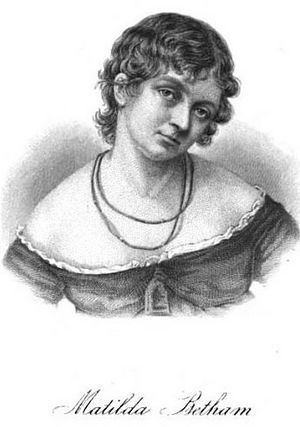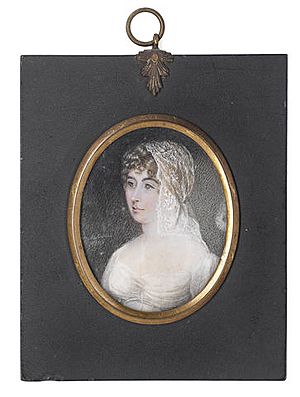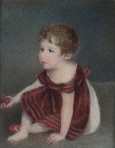Mary Matilda Betham facts for kids
Quick facts for kids
Mary Matilda Betham
|
|
|---|---|

Matilda Betham, estimate 1794–1820
|
|
| Born | 16 November 1776 Stradbroke, Suffolk, England
|
| Died | 30 September 1852 (aged 75) London, England
|
| Resting place | Highgate Cemetery, London |
| Nationality | British |
| Education |
|
| Known for | Poet, woman of letters, and miniature portrait painter |
Mary Matilda Betham (born November 16, 1776 – died September 30, 1852) was an amazing English artist and writer. Her family and friends knew her as Matilda Betham. She was a diarist, a poet, a writer, and a painter of tiny portraits.
Matilda showed her paintings at the Royal Academy of Arts from 1804 to 1816. She published her first book of poems in 1797. For six years, she studied famous women from history. This research led to her book, A Biographical Dictionary of the Celebrated Women of Every Age and Country, published in 1804.
Contents
Early Life and Learning
Matilda Betham was the oldest of 14 children. She was born in Stradbroke, Suffolk, England. Her father, Rev. William Betham, was a schoolmaster and a church leader. He also wrote books about royal families and English history.
Matilda grew up in Stonham Aspal. She had a happy childhood, even though she sometimes had health problems. She mostly taught herself by reading books in her father's large library. This made her very interested in history and literature. From a young age, she loved to read plays and history books. She also enjoyed reciting poetry.
To balance her love for books, Matilda was sent for sewing lessons. She also learned to speak French during trips to London. Her younger brother, William Betham (1779–1853), also became a well-known writer.
As her family grew, Matilda felt she needed to earn her own money. She taught herself how to paint miniature portraits. A visit to her uncle Edward Beetham in London inspired her. His family lived in a lively area for artists and writers. She met the artist John Opie there and even took lessons from him. Her uncle, who was a publisher, also encouraged her writing. In 1796, she studied with the famous poet William Wordsworth. She also learned Italian from Agostino Isola in Cambridge.
Becoming a Writer and Artist

In 1797, Matilda published her first book, Elegies, and Other Small Poems. It included poems she translated from Italian and a story called Arthur & Albina. The famous poet Samuel Taylor Coleridge praised her work. In 1802, he wrote a poem called To Matilda from a Stranger, comparing her to the ancient poet Sappho. He encouraged her to keep writing.
Matilda painted beautiful, detailed portraits. She showed them at the Royal Academy of Arts from 1804 to 1816. This helped her become financially independent. She painted many important people, including the Duchess of St Albans and the poet George Dyer. She also painted her father and other family members.
In 1804, Matilda published her important book, A Biographical Dictionary of the Celebrated Women of Every Age and Country. This book took her six years to research. It had short life stories of famous women from all over the world and from different times. These included Mary Magdalene, Cleopatra, and Madame Roland. Four years later, she published her second book of poetry.
Matilda was good friends with many famous writers. These included Robert Southey and his wife, Anna Laetitia Barbauld, and Charles and Mary Lamb. She also knew Samuel Taylor Coleridge. She painted portraits of the Coleridge and Southey families.
Matilda also wrote articles for magazines without using her name. She even gave public readings of Shakespeare's plays in London. Her most popular poem was Lay of Marie (1816). It was based on the story of Marie de France, a medieval poet. Robert Southey thought she was "likely to be the best poetess of her age."
Later Life and Challenges
After a difficult period, Matilda stopped her writing career for a while. She faced health challenges and financial problems. For example, there were mistakes in advertisements for her book, and many of her printed books got ruined. She struggled to find work painting portraits because she couldn't afford nice clothes.
Around 1819, Matilda went through a very difficult time with her health. She said she had a "nervous fever" from all the hard work and stress of publishing Lay of Marie. She felt she was unfairly placed in a care facility. By 1820, she was acting and talking normally again. After leaving, she moved to London and kept her address a secret. Friends helped her get financial aid from the Royal Literary Fund, which helps authors.
Matilda was a strong supporter of women's rights. She believed women should have a bigger say in government. She wrote a piece called Challenge to Women. It asked women to support Queen Caroline during her difficult marriage to King George IV. Matilda urged women to sign a petition to help the Queen.
In the 1830s, Matilda lived with her parents. She continued to write, expressing sadness about the death of her siblings in her book Sonnets and Verses, To Relations and their Connexions. She also wrote a play called Hermoden, but the manuscript was lost. She was also reported to be studying at the British Museum during this time.
- Though Age advances, strength decays,
- Enjoyments come a thousand ways—
- The bending trunk of Life's old tree
- Still blossoms forth abundantly!
In her later years, Matilda returned to London. She kept her friendships, her love of books, and her clever sense of humor. However, it was still hard for her to earn a living. She couldn't get help to print a new manuscript called Crow-quill Flights. Some of her old writings were even accidentally burned.
Mary Matilda Betham passed away on September 30, 1852, in London. She was buried in Highgate Cemetery with her older sister, Theresa. Her niece, the novelist Matilda Betham-Edwards, wrote about her in Six Life Stories of Famous Women (1880). However, her niece also sadly burned many of Matilda's letters.
Works
Literary Works
- Elegies, and Other Small Poems (1797)
- A Biographical Dictionary of the Celebrated Women of Every Age and Country (1804)
- Poems (1808)
- Lay of Marie (1816)
- Sonnets and Verses, To Relations and their Connexions (about 1836)
- Dramatic Sketch (1836)
Paintings Exhibited at the Royal Academy
Matilda Betham showed these paintings at the Royal Academy of Arts between 1804 and 1816:
- Miss Armstrong, by 1808
- F. F. Baker, Esq., by 1805
- Harriot Beauclerk, Duchess of St Albans, by 1804
- Miss B. Betham, by 1811
- Miss E Betham, by 1806
- Mrs. J. Betham, by 1816
- Miss M. Betham, by 1805
- Mr. R. G. Betham, by 1810
- Mrs. R. G. Betham, by 1816
- Rev. William Betham, by 1810
- Rev. William Betham, by 1812
- Mr. Boughton, by 1806
- Sir C. R. Boughton , by 1806
- Miss R. Boughton, by 1807
- Miss Rouse Boughton, by 1805
- Miss Chesshyre, by 1806
- Mr. Cromie, by 1805
- Miss A. Dove, by 1816
- Miss Duncan, by 1810
- George Dyer, poet, by 1807
- Countess of Dysart, by 1804
- Rt. Hon. Lady Fauconberg, by 1806
- Mr. Finucane, by 1805
- Gaiety, miniature, by 1808
- Rt. Hon. Lady E. Gamon, by 1807
- Mrs. Colonel Gardner, by 1816
- Miss M. Graham, by 1807
- Mr. Manners, by 1804
- Miss Manners, by 1804
- Portrait of a lady, by 1807
- Portrait of a lady, by 1808
- Portrait of Mr. de Venville, Mr. Southey the poet, and Messrs. C. and G. Betham, by 1808
- Mrs. Pymar, by 1812
- Mr. Saxon, by 1807
- Self portrait, by 1810
- Rev. P. Stockdale, by 1811
- Mrs. C. Thompson, by 1807
- Master F. Thompson, by 1807
- Lady Wilson, by 1806
A Historical Mix-Up
In 1804, Matilda Betham made a small mistake in her famous dictionary. She thought a male sculptor named Kresilas was a woman named Cresilla. She believed "Cresilla" had won third place in a competition to sculpt Amazons for the Temple of Artemis at Ephesus. Because of this, Kresilas was later mistakenly included in artist Judy Chicago's artwork, The Dinner Party, which celebrates women in history.
See also
- Isabella Beetham, her sister-in-law, a silhouette artist
- Jane Beetham Read, her cousin, a miniature and silhouette portrait painter
- William Betham (1779–1853), her brother, an English herald and antiquarian



